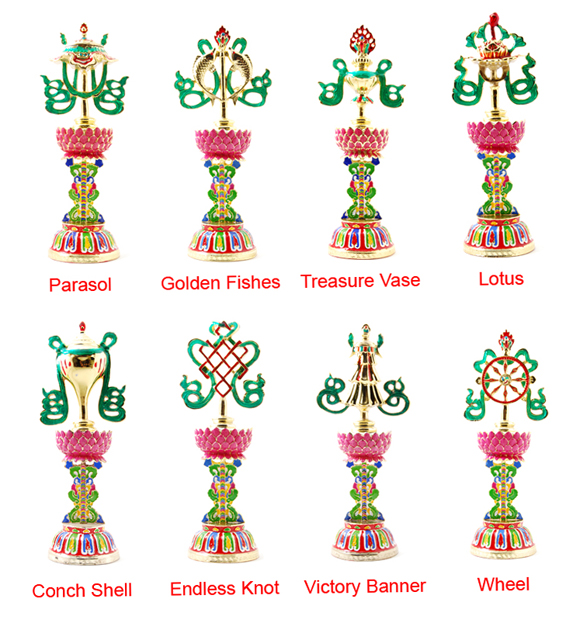The Mandala is also a part of Hindu Tantrism and in other traditions like North American Indians, but this article will only focus on the Buddhist Mandala.
Mandala comes from Sanskrit meaning "circle." Even though it may be dominated by squares or triangles, a Mandala has a concentric structure. Mandalas are far more than geometrical figures, however. For Tantric Buddhists, they are rich with symbolism and sacred meaning. In fact, the etymology of the word "Mandala" suggests not just a circle, but a "container of essence."
A Mandala becomes a sacred area that serves for deities and a collection point of universal forces. By mentally entering a Mandala and proceeding to its center, a person is symbolically guided through the cosmos to the essence of reality.
In Tibetan Buddhism, contemplation of sacred images is central to religious ritual, and a Mandala is one of the most important of these sacred images. A Tibetan Mandala is usually made with careful placement of colored sand, and accordingly is known in Tibetan as "dul-tson-kyil-khor", or Mandala of the colored powders.
The symbolism of the Mandala in the tradition of Vajrayana Buddhism, Mandalas are rich with symbolism that evokes various aspects of Buddhist teaching. This is part of what makes the creation of a Mandala a sacred act, for as they work, the monks are imparting the Buddha's teachings. In the Tibetan Buddhism, Mandalas have been developed into a sand painting. They are also a key part of * Anuttarayoga Tantra meditation practice.
Nyingma tradition and the teachings of Dzongchen or the Great perfection is the Highest Tantra. Nyingma lineage is the oldest of the four major schools of Tibetan Buddhism, and founded by the great Indian master of Guru Rinpoche, Padmasambhava who came to Tibet in the eighth century C.E.
Commonly , there are four monks are working together to construct a Mandala. The mandala is divided into quadrants with one monk assigned to each. Midway through the process, each monk receives an assistant who helps fill in the colors while the primary monk continues to work on detailed outlines.
The square structure in the middle of a mandala is a palace for the resident deities and a temple containing the essence of the Buddha. The square temple's four elaborate gates symbolize a variety of ideas, including:
- The four boundless thoughts: loving-kindness, compassion, sympathy and equanimity
- The four directions: south, north, east and west
Within the square palace or temple are images of deities, which are usually the * Five Dhyani Buddhas (the Great Buddhas of Wisdom). The iconography of these Buddhas are rich in symbolism in itself. Each of the Five Dyani Buddhas represents a direction (center, south, north, east and west), cosmic element (like form and consciousness), earthly element (ether, air, water, earth and fire), and a particular type of wisdom.
Each Buddha is empowered to overcome a particular evil, such as ignorance, envy or hatred. The Five Dyani Buddhas are generally identical in appearance, but are each represented iconography with a particular color, mudra (hand gesture), and animal. See the article on the Five Dyani Buddhas for more information.
In the center of the mandala is an image of the chief Buddha or Deity, who is placed over the center dot described above. Because it has no dimensions, the center dot represents the seed or the center of the universe.
*For more detailed of the Five Dhyani Buddhas, please visit our article as follows:-
http://max-tibetanbuddhism.blogspot.my/search?q=Dhyani+Buddhas+
The Destruction of The San Mandala
* Anuttarayoga Tantra or Highest Yoga Tantra is a term used in Tibetan Buddhism. In accordance with the three lineages of Kagyu, Sakya and Gelug of Tibetan Buddhism, Anuttarayoga Tantra is the highest of four classes and is associated with the route to enlightenment.
Nyingma tradition and the teachings of Dzongchen or the Great perfection is the Highest Tantra. Nyingma lineage is the oldest of the four major schools of Tibetan Buddhism, and founded by the great Indian master of Guru Rinpoche, Padmasambhava who came to Tibet in the eighth century C.E.
Footnote
The practice of Anuttarayoga Tantra in the Vajrayana tradition of Buddhism is characterized by the requirement of empowerment from a qualified Guru, Lama, use of ritual techniques, and the practice of various meditative and subtle body yogas, to effect personal transformation and to attain enlightenment through the realization of the mind stream as a Meditational Deity, or a Yidam. Mandalas have complex geometrical shapes and are often used for meditation.
For more teachings of the Tantra, please visit and click here
Construction of the sacred Mandala
The basic form of most Mandala is a square with four gates containing a circle with a center point. Each gate is in the general shape of a "T". The process of constructing a Mandala is a sacred ritual. It is a meditative, painstaking process that can take days or even weeks to complete. Before a monk may participate in the construction of a Mandala, he must undergo a lengthy period of artistic and philosophical study. For more teachings of the Tantra, please visit and click here
Construction of the sacred Mandala
Mandalas are constructed from the center outward, beginning with a dot in the center. With the placement of the center dot, the mandala is consecrated to a particular Buddha or Deity. This Buddha or Deity will usually be depicted in an image over the center dot, although some Mandalas are purely geometric.
The symbolizes of the sacred Mandala
Lines are then drawn through the center dot to the four corners, creating triangular geometric patterns. These lines are then used to construct a square "palace" with four gates. The monks usually keep to their own quadrant at this point.
The symbolizes of the sacred Mandala
Lines are then drawn through the center dot to the four corners, creating triangular geometric patterns. These lines are then used to construct a square "palace" with four gates. The monks usually keep to their own quadrant at this point.
From the inner square, the monks move outward in a series of concentric circles. Here the monks work in tandem, moving all around the mandala. They wait until each section is entirely completed before moving outward together. This ensures that balance is always maintained.
Outside the square temple is several concentric circles. The outermost circle is usually decorated with stylized scroll work resembling a ring of fire. This ring of fire symbolizes the process of transformation humans must undergo before being able to enter the sacred territory within. It both bars the uninitiated and symbolizes the burning of ignorance.
The next circle inward is a ring of thunderbolt or diamond scepters, which stands for indestructibility and illumination. This is followed by a circle of eight graveyards, representing the eight aspects of human consciousness that bind a person to the cycle of rebirth. Finally, the innermost ring is made of lotus leaves, signifying religious rebirth.
The Five Dhyani Buddhas Mandala
- The four boundless thoughts: loving-kindness, compassion, sympathy and equanimity
Within the square palace or temple are images of deities, which are usually the * Five Dhyani Buddhas (the Great Buddhas of Wisdom). The iconography of these Buddhas are rich in symbolism in itself. Each of the Five Dyani Buddhas represents a direction (center, south, north, east and west), cosmic element (like form and consciousness), earthly element (ether, air, water, earth and fire), and a particular type of wisdom.
Each Buddha is empowered to overcome a particular evil, such as ignorance, envy or hatred. The Five Dyani Buddhas are generally identical in appearance, but are each represented iconography with a particular color, mudra (hand gesture), and animal. See the article on the Five Dyani Buddhas for more information.
In the center of the mandala is an image of the chief Buddha or Deity, who is placed over the center dot described above. Because it has no dimensions, the center dot represents the seed or the center of the universe.
*For more detailed of the Five Dhyani Buddhas, please visit our article as follows:-
http://max-tibetanbuddhism.blogspot.my/search?q=Dhyani+Buddhas+
The Destruction of The San Mandala
Although some Mandalas are painted and serve as an enduring object of contemplation, the traditional Tibetan sand Mandala, when completed, is deliberately destroyed. The destruction of a sand mandala is also highly ceremonial. Even the Deity syllables are removed in a specific order along with the rest of the geometry until at last the mandala has been dismantled.
The sand is collected in a jar which is then wrapped in silk and transported to a river (or any place with moving water), where it is released back into nature. This symbolizes the ephemerality of life and the world.
Donation
Do you earnestly cherish our devoted work? Assuming this is the case, we are delighted that you are finding our blog useful and valuable. Would you consider making a donation for our Buddhist research and development?
We need your help to secure the future of scholarly interaction with Buddhism. Since our very first publication of Dharma works and activities in the year 2008, we had been effortlessly providing free distribution of Dharma posts and articles throughout the previous 10 years. We have exceptionally constrained supports and do not receive subsidized or funding from people in general.
Please help us and to develop our Dharma activities that will not only benefit you, but to all Dharma readers on the planet. Please consider showing your support. Your generosity will certainly help us to enhance our work and to accomplish for a better and brighter prospect to come.
Thank you for reading, may you find peace and great bliss. With your support it helps to spread the Buddha’s precious teachings and turning the Dharma wheels in the world.
Aspiration For Bodhichitta
For those in whom the precious Bodhichitta has not arisen
May it arise and not decrease
But increase further and further.
Dedication of Merit
By this merit may we obtain omniscience then.
Having defeated the enemies wrong-doings.
May we liberate migrators from the ocean of existence.
With its stormy waves of birth, old age, sickness and death.
*Note
I do not own or infringe any copyright of the picture(s).
Picture(s) courtesy and credit to the rightful distributors and or studios.
Picture(s) is/are intended for editorial use only.
The sand is collected in a jar which is then wrapped in silk and transported to a river (or any place with moving water), where it is released back into nature. This symbolizes the ephemerality of life and the world.
Donation
Do you earnestly cherish our devoted work? Assuming this is the case, we are delighted that you are finding our blog useful and valuable. Would you consider making a donation for our Buddhist research and development?
We need your help to secure the future of scholarly interaction with Buddhism. Since our very first publication of Dharma works and activities in the year 2008, we had been effortlessly providing free distribution of Dharma posts and articles throughout the previous 10 years. We have exceptionally constrained supports and do not receive subsidized or funding from people in general.
Please help us and to develop our Dharma activities that will not only benefit you, but to all Dharma readers on the planet. Please consider showing your support. Your generosity will certainly help us to enhance our work and to accomplish for a better and brighter prospect to come.
Aspiration For Bodhichitta
For those in whom the precious Bodhichitta has not arisen
May it arise and not decrease
But increase further and further.
Dedication of Merit
By this merit may we obtain omniscience then.
Having defeated the enemies wrong-doings.
May we liberate migrators from the ocean of existence.
With its stormy waves of birth, old age, sickness and death.
*Note
I do not own or infringe any copyright of the picture(s).
Picture(s) courtesy and credit to the rightful distributors and or studios.
Picture(s) is/are intended for editorial use only.







































